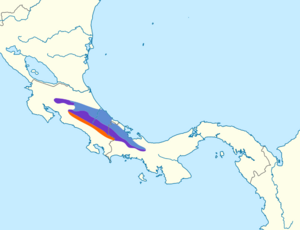Red-fronted parrotlet facts for kids
Quick facts for kids Red-fronted parrotlet |
|
|---|---|
| Conservation status | |
| Scientific classification | |
| Genus: |
Touit
|
| Species: |
costaricensis
|
 |
|
| Synonyms | |
|
|
The red-fronted parrotlet (Touit costaricensis) is a small, colorful bird. It is a type of parrot found in the forests of Costa Rica and Panama. Scientists consider it a species that is Near Threatened, meaning it needs our help to protect its home.
Contents
What's in a Name?
The red-fronted parrotlet is part of the parrot family, Psittacidae. It is closely related to the blue-fronted parrotlet. Some people used to think they were the same kind of bird, but now they are known as separate species. This parrotlet was officially named by Charles B. Cory in 1913.
What Does it Look Like?
This parrotlet is about 15 to 17 centimeters (6 to 7 inches) long. It weighs around 80 grams (2.8 ounces), which is about as much as a small apple. Most of its body is green, with darker green on its back and lighter green underneath.
It has a bright red forehead and face. There's a little bit of blue on its face and a white ring around its eye. The top of its head and the back of its neck are a bronze-green color. Its throat is yellowish.
You can see a lot of red on its wing where it bends, like a wrist. Its main flight feathers are black with green edges. The feathers under its wings are yellow. Its tail is square-shaped. The middle tail feathers are black, and the others are yellow with black tips. Male parrotlets usually have more red on their faces than females. Young parrotlets have almost no red at all.
Where it Lives
The red-fronted parrotlet lives in western Costa Rica and western Panama. It can be found as far east as Coclé Province in Panama. It is more common on the Caribbean side of the mountains than on the Pacific side.
During the dry season, these birds live in very wet and cool evergreen mountain forests. They can be found high up, sometimes as high as 3,000 meters (9,800 feet). When the rainy season starts, they move to lower rainforests.
How it Behaves
Moving Around
The red-fronted parrotlet is an "elevational migrant." This means it moves up and down mountains depending on the season. In the dry season, it stays high up. In the rainy season, it moves to lower areas, sometimes even down to sea level. However, you can usually find them year-round between 500 and 1,500 meters (1,600 to 4,900 feet) in elevation.
What it Eats
This parrotlet usually looks for food in the tops of trees. It also eats from plants that grow on other plants, called epiphytes. Its diet is mostly fruit. It especially likes fruits from plants in the Melastomataceae and Ericaceae families.
What it Sounds Like
The red-fronted parrotlet has a special call. It sounds like a high-pitched, questioning "chheee? chee, che-de-de-dee." When it flies, its call is a slightly nasal "kyee kyee."
Protecting the Parrotlet
The IUCN (International Union for Conservation of Nature) first listed the red-fronted parrotlet as "Near Threatened." Then, for a while, it was considered "Vulnerable," which means it was in more danger. But since 2021, it's back to "Near Threatened."
There are fewer than 12,000 adult red-fronted parrotlets left in the wild, and their numbers are slowly going down. They live in a somewhat small area. However, not much of their forest home is being destroyed, especially in the mountains. This means they are not facing huge threats right now. Even though they are uncommon, they can handle some changes to their habitat. People also don't usually capture them to sell as pets.


